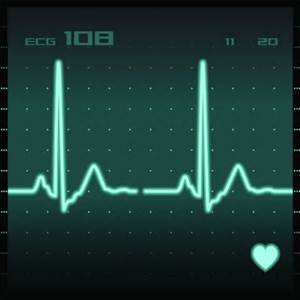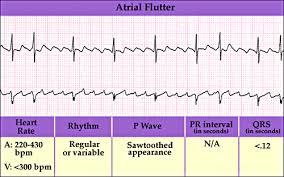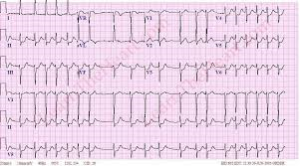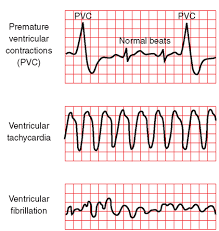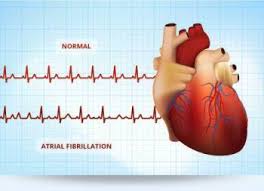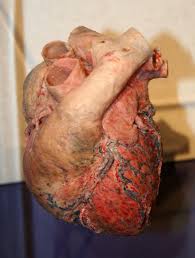Above-Normal Sinus Rhythm Best rhythm to be in.
Above-Atrial Fibrillation-rapid rate = Uncontrolled and Controlled is under 100 HB/minute
Notice in the PVC and V Tac above the QRS that is wide & in V Fib you see no distinct waves
all fibrillation meaning nothing is working right (NO distinct P wave-you seen none in Ventricular
rhythms to begin with but no QRS or T or U waves) because their are none just fibrillation.
Cardiac arrest is the abrupt loss of heart function in a person who may or may not have diagnosed heart disease. The time and mode of death are unexpected. It occurs instantly or shortly after symptoms appear.
Each year, more than 420,000 emergency medical services-assessed out-of-hospital cardiac arrests occur in the United States.
No. The term “heart attack” is often mistakenly used to describe cardiac arrest. While a heart attack may cause cardiac arrest and sudden death, the terms don’t mean the same thing. Heart attacks are caused by a blockage that stops blood flow to the heart. A heart attack (or myocardial infarction) refers to death of heart muscle tissue due to the loss of blood supply, not necessarily resulting in the death of the heart attack victim.
Cardiac arrest is caused when the heart’s electrical system malfunctions. In cardiac arrest death results when the heart suddenly stops working properly. This may be caused by abnormal, or irregular, heart rhythms (called arrhythmias). A common arrhythmia in cardiac arrest is ventricular fibrillation.
Where in atrial fibrillation the impulse or heart beat intially starts its conduction down the heart to the bottom of the ventricles and with the pulse under 100 = Controlled AFib, you can live a normal life with. With AFib the atriums are chaotic.
AF occurs if rapid, disorganized electrical signals cause the heart’s two upper chambers—called the atria (AY-tree-uh)—to fibrillate. The term “fibrillate” means to contract very fast and irregularly.
In AF, blood pools in the atria. It isn’t pumped completely into the heart’s two lower chambers, called the ventricles (VEN-trih-kuls). As a result, the heart’s upper and lower chambers don’t work together as they should.
Ventricular Fibrillation doing the same thing but in a lower area of the heart and now in the lower chambers called the Ventricles=much more serious and dangerous if no immediate treatment than death occurs. This is when the heart’s lower chambers suddenly start beating chaotically and don’t pump blood. Death occurs within minutes after the heart stops. Cardiac arrest may be reversed if CPR (cardiopulmonary resuscitation) is performed and a defibrillator is used to shock the heart and restore a normal heart rhythm within a few minutes.
Heart Attack and Cardiac Arrest
People often use these terms interchangeably, but they are not synonyms. A heart attack is when blood flow to the heart is blocked, and sudden cardiac arrest is when the heart malfunctions and suddenly stops beating unexpectedly. A heart attack is a “circulation” problem and sudden cardiac arrest is an “electrical” problem.
What is a heart attack?
A heart attack occurs when a blocked artery prevents oxygen-rich blood from reaching a section of the heart. If the blocked artery is not reopened quickly, the part of the heart normally nourished by that artery begins to die. The longer a person goes without treatment, the greater the damage. Symptoms of a heart attack may be immediate and intense. More often, though, symptoms start slowly and persist for hours, days or weeks before a heart attack. Unlike with sudden cardiac arrest, the heart usually does not stop beating during a heart attack. The heart attack symptoms in women can be different than men. A heart attack actually caused scarring to the heart since it causes damaging to the heart muscle tissue.
What is cardiac arrest?
Sudden cardiac arrest occurs suddenly and often without warning. It is triggered by an electrical malfunction in the heart that causes an irregular heartbeat (arrhythmia). With its pumping action disrupted, the heart cannot pump blood to the brain, lungs and other organs. Seconds later, a person loses consciousness and has no pulse. Death occurs within minutes if the victim does not receive treatment.
Fast action can save lives. Find out what to do if someone experiences a heart attack or cardiac arrestFast action can save lives. Find out what to do if someone experiences a heart attack or cardiac arrest.Fast action can save lives. Find out what to do if someone experiences a heart attack or cardiac arrest.
What to do: Heart Attack
Even if you’re not sure it’s a heart attack, don’t wait more than five minutes to call 9-1-1 or your emergency response number. Every minute matters! It’s best to call EMS to get to the emergency room right away. Emergency medical services staff can begin treatment when they arrive — up to an hour sooner than if someone gets to the hospital by car. EMS staff are also trained to revive someone whose heart has stopped. Patients with chest pain who arrive by ambulance usually receive faster treatment at the hospital, too.
What to do: Sudden Cardiac Arrest
Cardiac arrest is reversible in most victims if it’s treated within a few minutes. First, call 9-1-1 for emergency medical services. Then get an automated external defibrillator if one is available and use it as soon as it arrives. Begin CPR immediately and continue until professional emergency medical services arrive. If two people are available to help, one should begin CPR immediately while the other calls 9-1-1 and finds an AED. Learn CPR you may just save someone one day being at the right place at the right time.
